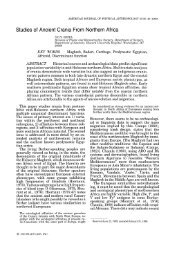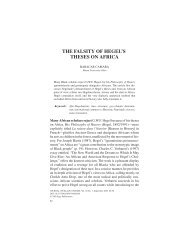Dutch Slavery and Slave Trade in the Indian Ocean
Dutch Slavery and Slave Trade in the Indian Ocean
Dutch Slavery and Slave Trade in the Indian Ocean
Create successful ePaper yourself
Turn your PDF publications into a flip-book with our unique Google optimized e-Paper software.
150 journal of world history, june 2003<br />
dependency. 44 Indigenous sources <strong>in</strong> <strong>the</strong> <strong>Indian</strong> <strong>Ocean</strong> prescrib<strong>in</strong>g <strong>the</strong><br />
“peculiar <strong>in</strong>stitution” orig<strong>in</strong>ated from three major traditions: H<strong>in</strong>du,<br />
Muslim, <strong>and</strong> Sou<strong>the</strong>ast Asian. Throughout <strong>the</strong> <strong>Indian</strong> <strong>Ocean</strong> bas<strong>in</strong>,<br />
however, <strong>the</strong>re were significant geographical <strong>and</strong> chronological variations<br />
with<strong>in</strong> each of <strong>the</strong>se traditions.<br />
The normative texts circumscrib<strong>in</strong>g routes to slavery <strong>in</strong> H<strong>in</strong>duism<br />
were <strong>the</strong> law books (dharmasastras or smritis) of Manu <strong>and</strong> Narada.<br />
Manu “<strong>the</strong> Lawgiver” (third century b.c.e.), author of <strong>the</strong> prototypic<br />
dharma text, recognized seven types of slavery: persons (dasas) captured<br />
<strong>in</strong> battle; those enslaved <strong>in</strong> return for food; those born <strong>in</strong> <strong>the</strong><br />
house of <strong>the</strong> master; those who are bought; those <strong>in</strong>herited as part of<br />
patrimony; those who are given away by <strong>the</strong>ir parents; <strong>and</strong> those<br />
enslaved for not pay<strong>in</strong>g a f<strong>in</strong>e or <strong>in</strong> execution of a judicial decree. In<br />
one of <strong>the</strong> latest of <strong>the</strong> major dharmasastras, Narada (c. 300 c.e.) subdivided<br />
<strong>and</strong> added categories to br<strong>in</strong>g <strong>the</strong> number up to fifteen, <strong>in</strong>clud<strong>in</strong>g<br />
a child whose adoption was defective, while ano<strong>the</strong>r resulted from<br />
a lost wager. In addition, bondage for debt <strong>and</strong> nonpayment of taxes<br />
were <strong>in</strong>troduced as separate categories. 45<br />
In Islam, <strong>the</strong> authoritative sources, <strong>the</strong> Qur’an, Shari’a, <strong>and</strong> (to<br />
Sunni Muslims only) <strong>the</strong> <strong>in</strong>numerable hadiths (traditions), recognized<br />
four ma<strong>in</strong> ways of recruitment of slaves (‘Abd): capture of <strong>in</strong>fidels <strong>in</strong><br />
holy struggle (jihad) aga<strong>in</strong>st <strong>the</strong> “Abode of War” (dar al-Harb), tribute<br />
(bakt) required from vassal states beyond <strong>the</strong> Islamic frontiers, offspr<strong>in</strong>g<br />
from or birth to slave parents, <strong>and</strong> purchase by slave merchants<br />
known as “importers” or “cattle-dealers.” Raids <strong>and</strong> petty warfare by<br />
Muslims could at best be <strong>in</strong>terpreted as a genu<strong>in</strong>e jihad or holy war to<br />
extend <strong>the</strong> faith. In 1669, for <strong>in</strong>stance, <strong>the</strong> Pangeran Dipati of Jambi,<br />
a Muslim port city on <strong>the</strong> east coast of Sumatra, justified <strong>the</strong> equipp<strong>in</strong>g<br />
of armed vessels for a slave raid aga<strong>in</strong>st Ujang Salangh on <strong>the</strong> Malaysian<br />
Pen<strong>in</strong>sula argu<strong>in</strong>g that <strong>the</strong> <strong>in</strong>habitants “were hea<strong>the</strong>ns, <strong>and</strong> hence<br />
[<strong>the</strong> raid<strong>in</strong>g] could not be considered an <strong>in</strong>justice.” At worst, however,<br />
44 For <strong>the</strong> problematic nature of <strong>the</strong> term “slave” <strong>in</strong> an <strong>Indian</strong> <strong>Ocean</strong> context, see note<br />
12. Though <strong>the</strong> term “slave” is used <strong>in</strong> <strong>the</strong> text, relations of dependency <strong>and</strong> <strong>in</strong>equality normally<br />
ran across a cont<strong>in</strong>uum from freedom to slavery with permeable boundaries between<br />
various categories or population groups.<br />
45 The Laws of Manu, Vol. 8, G. Buhler, trans., The Sacred Books of <strong>the</strong> East, Vol. 25<br />
(Oxford, 1886), p. 415; The M<strong>in</strong>or Law-Books, Part I: Narada, Vol. V, J. Jolly, ed., The sacred<br />
books of <strong>the</strong> East, Vol. 33 (Oxford, 1889), pp. 26–28, 29, 31–36; B. Ste<strong>in</strong>, A History of India<br />
(Malden, Mass., 1998), pp. 216–20; U. Chakravarti, “Of Dasas <strong>and</strong> Karmakaras: Servile<br />
Labour <strong>in</strong> Ancient India,” <strong>in</strong> U. Patnaik <strong>and</strong> M. D<strong>in</strong>gawaney, eds., Cha<strong>in</strong>s of Servitude:<br />
Bondage <strong>and</strong> <strong><strong>Slave</strong>ry</strong> <strong>in</strong> India (New York, 1985), pp. 40–42, 51–54.




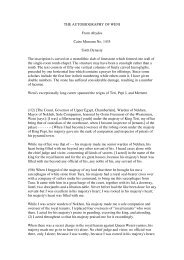
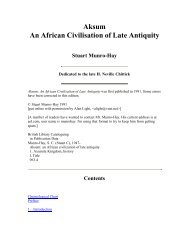
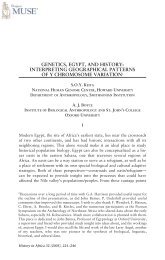

![The Negro trail blazers of California [microform] : a ... - Homestead](https://img.yumpu.com/32436613/1/174x260/the-negro-trail-blazers-of-california-microform-a-homestead.jpg?quality=85)

